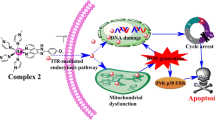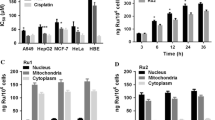Abstract
Ruthenium is attracting considerable interest as the basis for new compounds to treat diseases, and studies have shown that complexes with different structures have significant antineoplastic and antimetastatic potential against several types of tumors, including tumors resistant to cisplatin drugs. We examined the cytotoxic, genotoxic, and pro-apoptotic activities of six ruthenium complexes containing amino acid with general formulation [Ru(AA)(bipy)(dppb)]PF6, where AA = amino acid (alanine, glycine, leucine, lysine, methionine, or tryptophan); bipy = 2,2´-bipyridine; and dppb = [1,4-bis(diphenylphosphine)butane], against A549 (lung carcinoma) and K562 (chronic myelogenous leukemia) cancer cells. The results show that the ruthenium complexes tested were able to induce cytotoxicity in A549 and K562 cancer cells. Complex 1 containing alanine inhibited the cell viability of A549 and K562 tumor cells by inducing apoptosis, as evidenced by an increased number of Annexin V-positive cells and the induction of DNA damage and cell cycle arrest. Complex 1 was able to induce caspase-mediated apoptosis in K562 cells through the mitochondrial dysfunction, the upregulation of apoptotic genes, and the downregulation of Bcl2 anti-apoptotic gene. Besides being cytotoxic to K562 and A549 cells, ruthenium complex containing alanine shows low cytotoxicity and genotoxicity against non-tumor cells. These results suggest that the ruthenium (II) complex is a potential safe and efficient antineoplastic candidate for leukemia treatment.





Similar content being viewed by others
References
Ndagi U, Mhlongo N, Soliman ME (2017) Metal complexes in cancer therapy - an update from drug design perspective. Drug Des Devel Ther 11:599–616. https://doi.org/10.2147/DDDT.S119488
Muhammad N, Guo Z (2014) Metal-based anticancer chemotherapeutic agents. Curr Opin Chem Biol 19:144–153
Blunden BM, Stenzel MH (2015) Incorporating ruthenium into advanced drug delivery carriers-an innovative generation of chemotherapeutics. J Chem Technol Biotechnol 90:1177–1195. https://doi.org/10.1002/jctb.4507
Riddell IA, Lippard SJ (2018) Cisplatin and oxaliplatin: our current understanding of their actions. In: Sigel A, Sigel H, Freisinger E, Sigel RKO (eds.) Metallo-Drugs: Development and Action of Anticancer Agents, Berlin, Boston: De Gruyter, pp 1–42. https://doi.org/10.1515/9783110470734-007
Brabec V, Novakova O (2006) DNA binding mode of ruthenium complexes and relationship to tumor cell toxicity. Drug Resist Updat 9:111–122
Farag AM, Guan TS, Osman H, Majid AMS, Iqbal MA, Ahamed MBK (2013) Synthesis of metal(II) [M = Cu, Mn, Zn] Schiff base complexes and their pro-apoptotic activity in liver tumor cells via caspase activation. Med Chem Res 22:4727–4736. https://doi.org/10.1007/s00044-013-0482-y
Shen D, Pouliot LM, Hall MD, Gottesman MM (2012) Cisplatin resistance: a cellular self-defense mechanism resulting from multiple epigenetic and genetic changes. Pharmacol Rev 64:706–721
Thota S, Rodrigues DA, Crans DC, Barreiro EJ (2018) Ru(II) compounds: next-generation anticancer metallotherapeutics? J Med Chem 26:5805–5821. https://doi.org/10.1021/acs.jmedchem.7b01689
Lima AP, Pereira FC, Almeida MAP, Mello FMS, Pires WC, Pinto TM, Delella FK, Felisbino SL, Moreno V, Batista AA, Silveira-Lacerda EP (2014) Cytotoxicity and apoptotic mechanism of ruthenium(II) amino acid complexes in sarcoma-180 tumor cells. PLoS One 9:e105865. https://doi.org/10.1371/journal.pone.0105865
Almeida MAP, Nascimento FB, Graminha AE, Ferreira AG, Ellena J, Mello FMD, Lima AP, Silveira-Lacerda EP, Batista AA (2014) Structural features and cytotoxic activities of [Ru(AA)(dppb)(bipy)]PF6 complexes. Polyhedron 81:735–742. https://doi.org/10.1016/j.poly.2014.07.024
Porto HKP, Vilanova-Costa CAST, Mello FMS, Costa WL, Lima AP, Pereira FC, Almeida MAP, Graminha AE, Batista AA, Silveira-Lacerda EP (2015) Synthesis of a Ru(II) tryptophan-associated complex and biological evaluation against Ehrlich murine breast carcinoma. Transit Met Chem 40:1–10. https://doi.org/10.1007/s11243-014-9882-1
Mello-Andrade F, da CostaWL PWC, Pereira FC, Cardoso CG, Lino-Junior RS, Irusta VRC, Carneiro CC, de Melo-Reis PR, Castro CH, Almeida MAP, Batista AA, Silveira-Lacerda EP (2017) Antitumor effectiveness and mechanism of action of Ru(II)/amino acid/diphosphine complexes in the peritoneal carcinomatosis progression. Tumour Biol 39(10):1010428317695933. https://doi.org/10.1177/1010428317695933
Mello-Andrade F, Cardoso CG, Silva CR, Chen-Chen L, Melo-Reis PR, Lima AP, Oliveira R, Ferraz IBM, Grisolia CK, Almeida MAP, Batista AA, Silveira-Lacerda EP (2018) Acute toxic effects of ruthenium (II)/amino acid/diphosphine complexes on Swiss mice and zebrafish embryos. Biomed Pharmacother 107:1082–1092. https://doi.org/10.1016/j.biopha.2018.08.051
Mosmann T (1983) Rapid colorimetric assay for cellular growth and survival: application to proliferation and cytotoxicity assays. J Immunol Methods 65:55–63
Singh NP, McCoy MT, Tice RR, Schneider ELA (1988) Simple technique for quantitation of low DNA levels of DNA damage in individual cells. Exp Cell Res 175:184–191
Cavalcante DG, Martınez CB, Sofia SH (2008) Genotoxic effects of roundup on the fish Prochilodus lineatus. Mutat Res 655:41–46
Lima AP, Pereira FC, Vilanova-Costa CA, Soares JR, Pereira LC, Porto HK, Pavanin LA, Santos WB, Silveira-Lacerda EP (2012) Induction of cell cycle arrest and apoptosis by ruthenium complex cis-(dichloro)tetramineruthenium(III) chloride in human lung carcinoma cells A549. Biol Trace Elem Res 147:8–15. https://doi.org/. https://doi.org/10.1007/s12011-011-9275-7
Chao H, Mei WJ, Huang QW, Ji LN (2002) DNA binding studies of ruthenium(II) complexes containing asymmetric tridentate ligands. J Inorg Biochem 92:165–170. https://doi.org/10.1016/S0162-0134(02)00543-3
Deshpande MS, Kumbhar AS (2005) Mixed-ligand complexes of ruthenium(II) incorporating a diazo ligand: synthesis, characterization and DNA binding. J Chem Sci 117:153–159. https://doi.org/10.1007/BF03356110
Liu SH, Zhu JW, Xu HH, Wang Y, Liu YM, Liang JB, Zhang GQ, Cao DH, Lin YY, Wu Y, Guo QF (2016) Protein-binding, cytotoxicity in vitro and cell cycle arrest of ruthenium(II) polypyridyl complexes. Spectrochim Acta A Mol Biomol Spectrosc 161:77–82. https://doi.org/10.1016/j.saa.2016.02.036
Zhang C, Han BJ, Zeng CC, Lai SH, Li W, Tang B, Wan D, Jiang GD, Liu YJ (2016) Synthesis, characterization, in vitro cytotoxicity and anticancer effects of ruthenium(II) complexes on BEL-7402 cells. J Inorg Biochem 157:62–72. https://doi.org/. https://doi.org/10.1016/j.jinorgbio.2016.01.003
Magalhães LF, Mello-Andrade F, Pires WC, Silva HD, da Silva PFF, Macedo LM, de Castro CH, Carneiro CC, Cardoso CG, de Melo Reis PR, Oliveira LC, Caetano RR, Batista AA, Silveira-Lacerda EP (2017) cis-[RuCl(BzCN)(bipy)(dppe)]PF6 induces anti-angiogenesis and apoptosis by a mechanism of caspase-dependent involving DNA damage, PARP activation, and Tp53 induction in Ehrlich tumor cell. Chem Biol Interact 278:101–113. https://doi.org/10.1016/j.cbi.2017.09.013
Pires WC, Lima BAV, de Castro PF, Lima AP, Mello-Andrade F, Silva HD, da Silva MM, Colina-Vegas L, Ellena J, Batista AA, Silveira-Lacerda EP (2018) Ru(II)/diphenylphosphine/pyridine-6-thiolate complexes induce S-180 cell apoptosis through intrinsic mitochondrial pathway involving inhibition of Bcl-2 and p53/Bax activation. Mol Cell Biochem 438:199–217. https://doi.org/10.1007/s11010-017-3129-3
Velozo-Sá VS, Pereira LR, Lima AP, Mello-Andrade F, Rezende MRM, Goveia RM, Pires WC, Silva MM, Oliveira KM, Ferreira AG, Ellena J, Deflon VM, Grisolia CK, Batista AA, Silveira-Lacerda EP (2019) In vitro cytotoxicity and in vivo zebrafish toxicity evaluation of Ru(II)/2-mercaptopyrimidine complexes. Dalton Trans 48:6026–6039. https://doi.org/doi. https://doi.org/10.1039/c8dt03738h
Kalkavan H, Green DR (2017) MOMP, cell suicide as a BCL-2 family business. Cell Death Differ 25(1):46–55. https://doi.org/10.1038/cdd.2017.179
Ojha R, Ishaq M, Singh SK (2015) Caspase-mediated crosstalk between autophagy and apoptosis: mutual adjustment or matter of dominance. J Can Res Ther 11:514–524
Galluzzi L, Vitale I, Abrams JM, Alnemri ES, Baehrecke EH, Blagosklonny MV, Dawson TM, Dawson VL, el-Deiry WS, Fulda S, Gottlieb E, Green DR, Hengartner MO, Kepp O, Knight RA, Kumar S, Lipton SA, Lu X, Madeo F, Malorni W, Mehlen P, Nuñez G, Peter ME, Piacentini M, Rubinsztein DC, Shi Y, Simon HU, Vandenabeele P, White E, Yuan J, Zhivotovsky B, Melino G, Kroemer G (2012) Molecular definitions of cell death subroutines: recommendations of the Nomenclature Committee on cell death 2012. Cell Death Differ 19:107–120. https://doi.org/. https://doi.org/10.1038/cdd.2011.96
Savry A, Carre M, Berges R, Rovini A, Pobel I, Chacon C, Braguer D, Bourgarel-Rey V (2013) Bcl-2-enhanced efficacy of microtubule-targeting chemotherapy through Bim overexpression: implications for cancer treatment. Neoplasia 15:49–60
Wang C, Youle RJ (2009) The role of mitochondria in apoptosis. Annu Rev Genet 43:95–118. https://doi.org/. https://doi.org/10.1146/annurev-genet-102108-134850
Jagtap P, Szabó C (2005) Poly(ADP-ribose) polymerase and the therapeutic effects of its inhibitors. Nat Rev Drug Discov 4:421–440. https://doi.org/10.1038/nrd1718
Krishnakumar R, Kraus WL (2010) The PARP side of the nucleus: molecular actions, physiological outcomes, and clinical targets. Mol Cell 39:8–24. https://doi.org/. https://doi.org/10.1016/j.molcel.2010.06.017
Michaud WA, Nichols AC, Mroz EA, Faquin WC, Clark JR, Begum S, Westra WH, Wada H, Busse PM, Ellisen LW, Rocco JW (2009) Bcl-2 blocks cisplatin-induced apoptosis and predicts poor outcome following chemoradiation treatment in advanced oropharyngeal squamous cell carcinoma. Clin Cancer Res 15:1645–1654. https://doi.org/10.1158/1078-0432.CCR-08-2581
Funding
This study was funded by Brazilian research financing institutions: Foundation for Research Support of the State of Maranhão (FAPEMA) [grant number PPP-02100/14], and Brazilian National Counsel of Technological and Scientific Development (CNPq) (grant number 454266/2014-6 and 31960/2008-3).
Author information
Authors and Affiliations
Corresponding author
Ethics declarations
Conflict of Interest
The authors declare that they have no conflict of interest or no financial conflict of interest to disclose. The authors Aliny Pereira de Lima, Márcio Aurélio Pinheiro Almeida, Francyelli Mello-Andrade, Alzir Azevedo Batista, and Elisângela de Paula Silveira-Lacerda report have a national patent application filing (number patent BR1020130336041A2).
Additional information
Publisher’s Note
Springer Nature remains neutral with regard to jurisdictional claims in published maps and institutional affiliations.
Rights and permissions
About this article
Cite this article
de Lima, A.P., Almeida, M.A.P., Mello-Andrade, F. et al. Ru(II)-Based Amino Acid Complexes Show Promise for Leukemia Treatment: Cytotoxicity and Some Light on their Mechanism of Action . Biol Trace Elem Res 197, 123–131 (2020). https://doi.org/10.1007/s12011-019-01976-0
Received:
Accepted:
Published:
Issue Date:
DOI: https://doi.org/10.1007/s12011-019-01976-0




